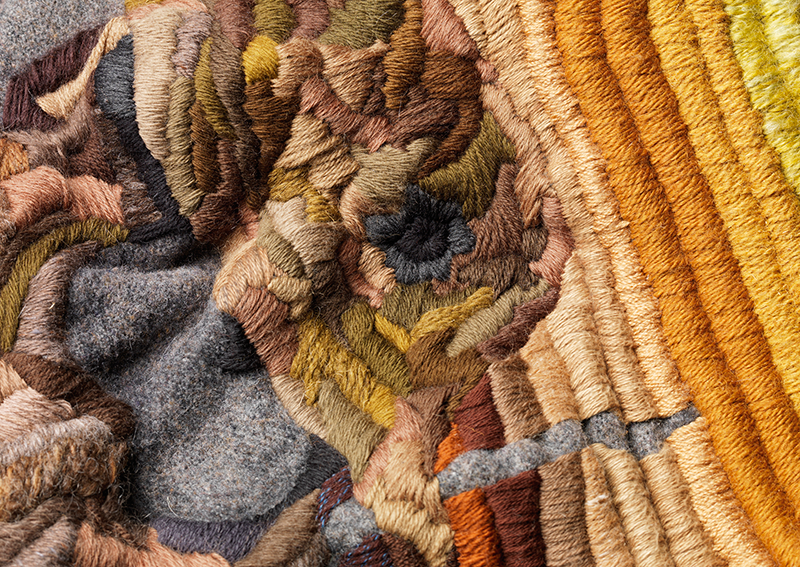A Thread Runs Through It: Sappers & Shrapnel

The Art Gallery of South Australia’s trench-art inspired Sappers & Shrapnel exhibition opens subtly with subdued colour and monochrome exhibits before bursting into colour at Ben Quilty’s refugee-inspired installation.
The contrast between the sparkly white wedding dresses and the multi-coloured life-vest-quilts overwhelms the visitor. Yet it is the stacks of UN blankets, placed in sombre grey piles around the room, which draws me in. They appear like islands of refuge in a sea of human suffering: grey, solid, square and orderly. Protective yet unemotional. Without demanding attention, they ground the exhibition, anchoring it with warmth and shelter.
Raghda Alrawi’s opulent white, rhinestone-encrusted wedding dresses represent joy and hope for the future. Beauty in the face of death. They float among the walls of brightly coloured life-vests embodying sadness, hopelessness and desperation. The emotion evoked by these vests is in extreme contrast to what we usually associate with bright colours: red, pink, blue and green.
Reinforcing the contrast between the clothes and the blankets, both the dresses and the life vests are made from mostly synthetic man-made fabric and notions, while the
piles of UN blankets are made from wool, a product derived from nature. This contrast between man-made emotion, both hopeful and hopeless, and nature-made stability, safety and protection is a subtle yet compelling metaphor for war.
 Installation view, Sappers & Shrapnel, Art Gallery of South Australia
Installation view, Sappers & Shrapnel, Art Gallery of South Australia
Entering Olga Cironis’s exhibition, the visitor is confronted with the presence of the feminine. From the embroidery wrapped toy guns to war memorabilia wrapped in human hair, war and its consequences are portrayed through the eyes of the mothers, daughters and wives of those who went off to war and those who brought war back home with them, whether in wounds or awards. Cironis’s use of human hair as a symbol of love and devotion invokes the same sense of protection as the blankets. By wrapping war medals in hair, she suggests the loving embrace and cocooning safety experienced by those who survived and returned home to the arms of their loved ones.
 Tjanpi Desert Weavers and Fiona Hall, Tjituru-tjituru (2015), photo: Rhett Hammerton
Tjanpi Desert Weavers and Fiona Hall, Tjituru-tjituru (2015), photo: Rhett Hammerton
Moving through the exhibition, the experience of emotions such as pain, loss, and death, as well as the scars of war, are coming closer to home. Tony Albert’s Universal Soldier and the Tjanpi Desert Weavers’ empty vehicles depicting the pain and futility caused by local, home-made conflict is a painful reminder that war is not always a distant event. It also happens inside the sanctuary of our homes, where blankets are not enough to protect us from the pain.
 Sera Waters, Front-line on the Home-front: Remembering Johns (2015-16), photo: courtesy Hugo Michell Gallery
Sera Waters, Front-line on the Home-front: Remembering Johns (2015-16), photo: courtesy Hugo Michell Gallery
A war blanket richly stitched with thick woollen threads in earthy shades of ochres, rusts, and browns wraps up the exhibition. Sera Waters remembers her family members’ sacrifices during war times by working like they did, repurposing material and improvising tools, to convey suffering, endurance, pain and injury. Again the blanket represents protection. This time it depicts the earth, the wounds of the landscape scarred by war.
Sappers & Shrapnel, curated by Lisa Slade, opens with blankets providing protection to desperate people and concludes with a blanket providing cover to a wounded earth. War leads to wounds and death. But war also leads to survival and hope. Looking at Sappers & Shrapnel, I see an exhibition wrapped in blankets.
Blankets of protection like a lifevest. Blankets of concealment like camouflage. Blankets of safety like a lovers’ embrace. Blankets of promise like hope for the future.
Sappers & Shrapnel: Contemporary art and the art of the trenches
Art Gallery of South Australia
Until Sunday, January 29
artgallery.sa.gov.au